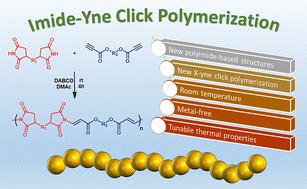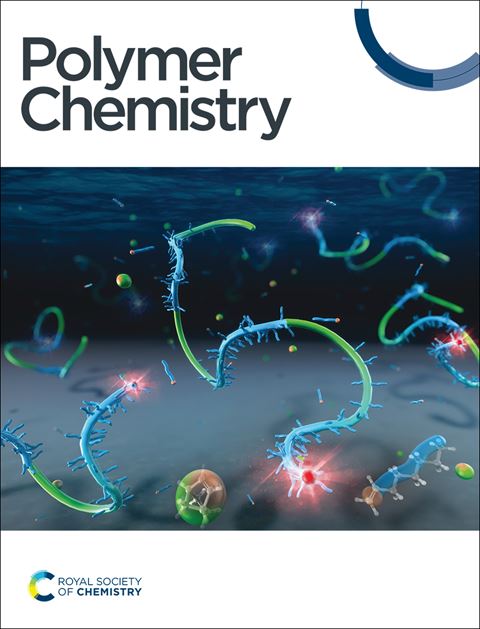Imide-yne click polymerization: a new and versatile tool for the toolbox of X-yne click polymerization†
IF 4.1
2区 化学
Q2 POLYMER SCIENCE
引用次数: 0
Abstract
The Michael reaction, a cornerstone in organic chemistry, continues to revolutionize the field with its unparalleled versatility in forming carbon–carbon, carbon–oxygen, carbon–nitrogen, and carbon–sulfur bonds, paving the way for groundbreaking advancements in complex molecule and macromolecule construction. In this study, imide-yne reaction was employed at the macromolecular level for the first time to prepare linear poly(imide ester)s. A wide range of bisimides and dipropiolates were reacted through imide-yne click polymerization in the presence of 1,4-diazabicyclo[2.2.2] octane (DABCO) at room temperature. The polymerizations proceed in an anti-Markovnikov fashion, yielding the E-isomer as the major product. Polymers were obtained in high yields and their molecular weights were found to be in the range of 5.64–12.67 kDa. The remaining unreacted double bonds in the linear polymers were found to undergo further functionalization with thiols using a strong organocatalyst 1,5,7-triazabicyclo[4.4.0]dec-5-ene (TBD), which was also supported by a model study. Post-polymerization modification study prompted us to prepare imide-yne monomers that can react with dithiols to synthesize poly(imide thioether)s through nucleophilic thiol–ene click reaction using TBD as the catalyst. The obtained polymers displayed a wide range of glass transition temperatures and thermal stability. Thus, it can be said that the proposed method enables the synthesis of new polyimide-based structures with tailorable thermal properties. It is believed that the proposed strategy will make a significant contribution to expanding the versatility of active alkyne chemistry at the macromolecular level.

亚胺炔单击聚合:X-炔单击聚合工具箱中的多功能新工具
迈克尔反应是有机化学的基石,它在形成碳-碳键、碳-氧键、碳-氮键和碳-硫键方面具有无与伦比的多功能性,为复杂分子和大分子结构的突破性进展铺平了道路,从而不断给有机化学领域带来革命性的变化。本研究首次在大分子水平上采用亚胺-炔反应制备线性聚(亚胺酯)。在室温下,在 1,4-二氮杂双环[2.2.2] 辛烷(DABCO)的存在下,通过亚胺-炔点击聚合反应了多种双亚胺和二丙二醇酯。聚合反应以反马尔科夫尼科夫方式进行,主要产物为 E 异构体。聚合物的产率很高,分子量在 5.64-12.67 kDa 之间。利用强有机催化剂 1,5,7-三氮杂双环[4.4.0]癸-5-烯 (TBD),发现线性聚合物中剩余的未反应双键可与硫醇进一步官能化,这也得到了模型研究的支持。聚合后改性研究促使我们制备了亚胺-炔单体,这些单体可以与二硫醇反应,以 TBD 为催化剂,通过亲核硫醇-烯点击反应合成聚(亚胺硫醚)。所获得的聚合物具有较宽的玻璃化转变温度范围和热稳定性。因此,可以说所提出的方法能够合成具有可定制热性能的新型聚酰亚胺基结构。相信所提出的策略将为在大分子水平上拓展活性炔化学的多功能性做出重大贡献。
本文章由计算机程序翻译,如有差异,请以英文原文为准。
求助全文
约1分钟内获得全文
求助全文
来源期刊

Polymer Chemistry
POLYMER SCIENCE-
CiteScore
8.60
自引率
8.70%
发文量
535
审稿时长
1.7 months
期刊介绍:
Polymer Chemistry welcomes submissions in all areas of polymer science that have a strong focus on macromolecular chemistry. Manuscripts may cover a broad range of fields, yet no direct application focus is required.
 求助内容:
求助内容: 应助结果提醒方式:
应助结果提醒方式:


